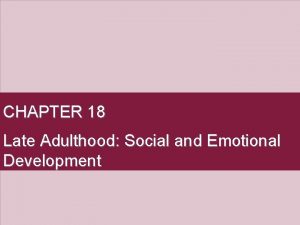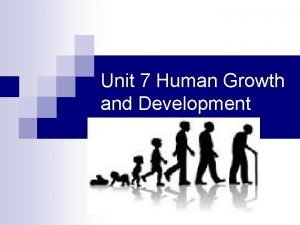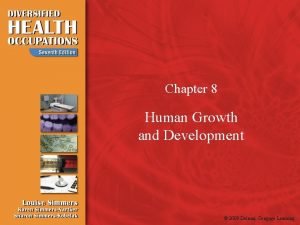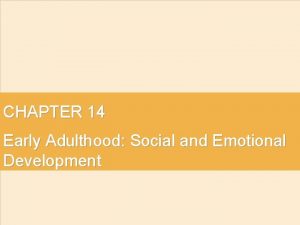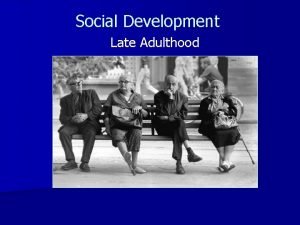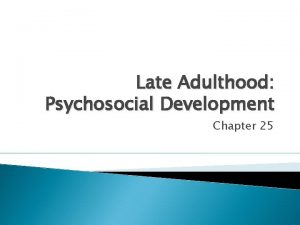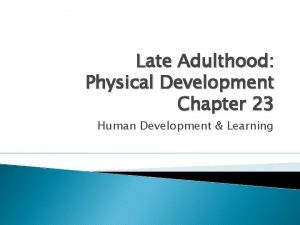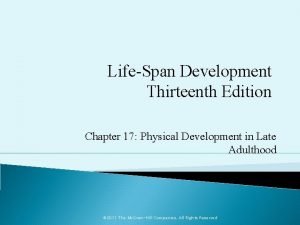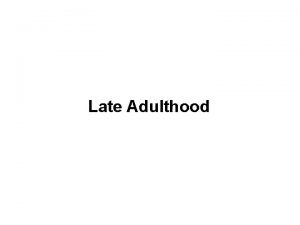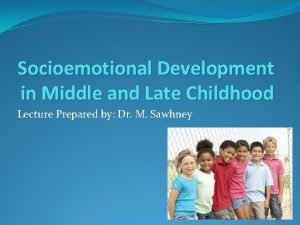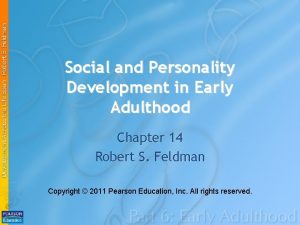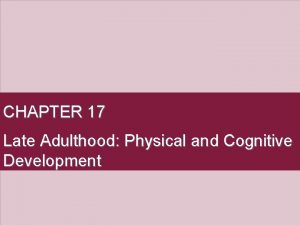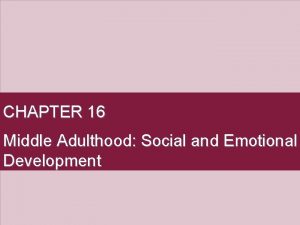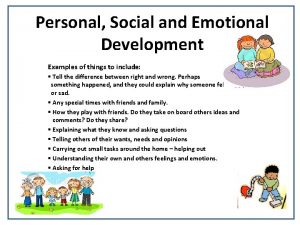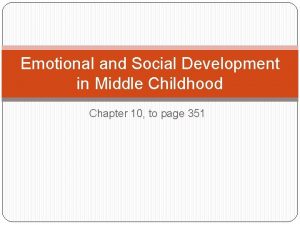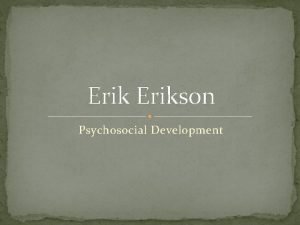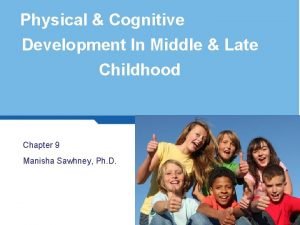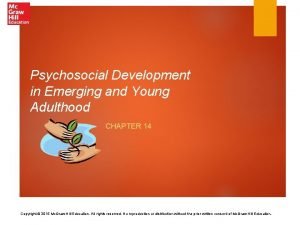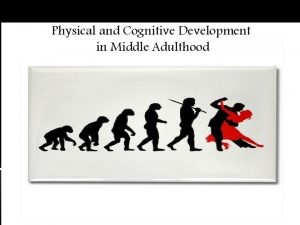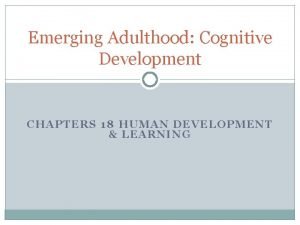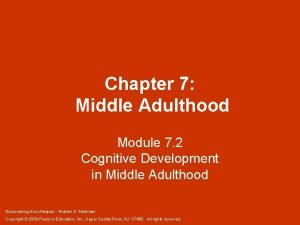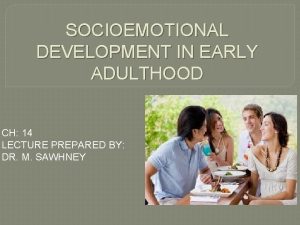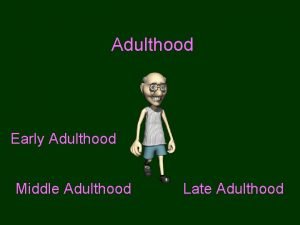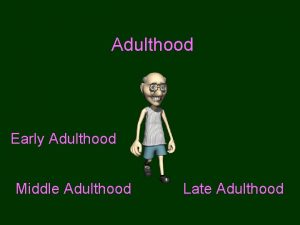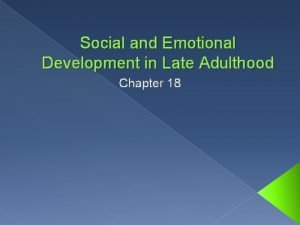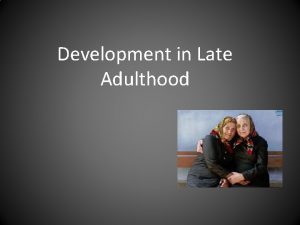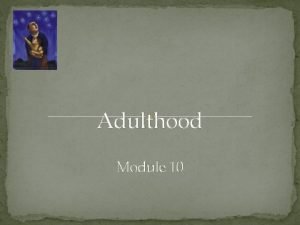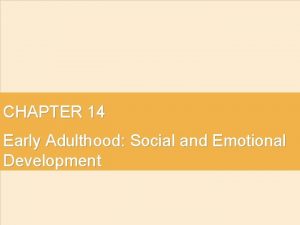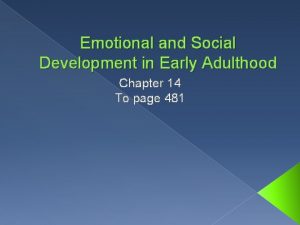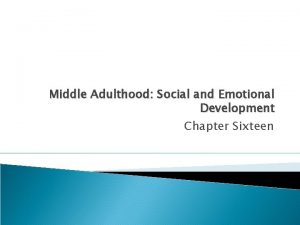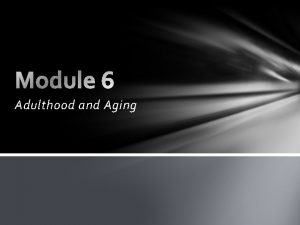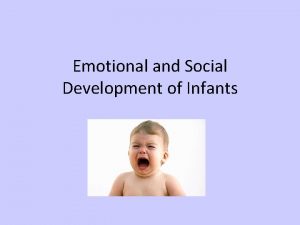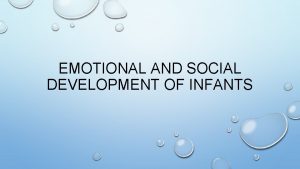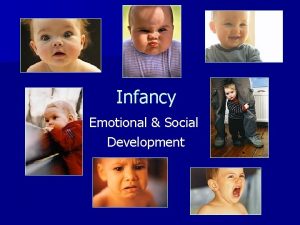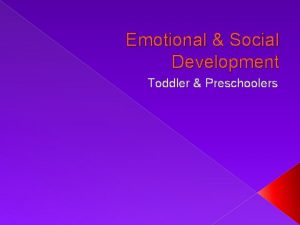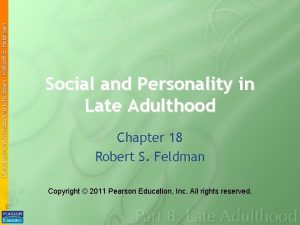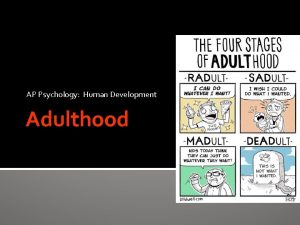Late Adulthood Social and Emotional Development Chapter 18































- Slides: 31

Late Adulthood: Social and Emotional Development Chapter 18

Theories of Social and Emotional Development in Late Adulthood Psychosocial Theory — eighth or final stage of life is called ego integrity or despair; he believed people who achieved positive outcomes to earlier life crisis would be more likely to obtain ego integrity than despair in late adulthood � Ego Integrity versus Despair — basic challenge is to maintain the belief that life is meaningful and worthwhile in the face of physical decline and the inevitability of death; ego integrity derives from wisdom, as well as from the acceptance of one’s life span as being limited and occurring at a certain point in history; adjustment in the later years requires wisdom to let go � Erikson’s

Robert Peck’s Developmental Tasks �Peck outlined three developmental tasks that people face in late adulthood: 1) Ego differentiation versus work-role preoccupation; 2) Body transcendence versus body preoccupation; 3) Ego transcendence versus ego preoccupation �Ardelt (2008) writes that ego transcendence grows out of self-reflection and willingness to learn from experience; ego transcendence is characterized by a concern for the well-being of humankind in general, not only of themselves and those they love

Robert Butler’s Life Review � Butler (2002) suggests reminiscence is a normal aspect of aging; life reviews are generally unguided; they can be extremely complex and nuanced; they can be incoherent and self-contradictory; life reviews attempt to make life meaningful, to help people move on with new relationships as others in their lives pass on, and to help them find ego integrity and accept the end of life � Butler (2002) argues helping professionals rely too much on drugs to ease the discomforts of older adults; pilot programs suggest therapists may be able to relieve depression and other psychological problems in older adults by helping them reminisce about their lives

Disengagement Theory � Disengagement theory — older people and society mutually withdraw from one another as older people approach death; people in late adulthood focus more on their inner lives, preparing for the inevitable; government or industry now supports them through pensions or charity rather than vice versa; family members expect less from them; older people and society prepare to let go of one another � Well-being among older adults is predicted by pursuing goals, rather than withdrawal

Activity Theory �Activity theory — older adults are better adjusted when they are more active and involved in physical and social activities �Physical activity is associated with a lower mortality rate in late adulthood; leisure and informal social activities contribute to life satisfaction among retired people; Israeli study found benefits for life satisfaction in activities involving the next generation, the visual and performing arts, and spiritual and religious matters, but there was also value in independent activities in the home

Self-Esteem � Robins et al (2002) recruited more than 300, 000 individuals, who completed an extensive on-line questionnaire which provided demographic information and measures of self -esteem; results indicated self-esteem of males was higher than that of females; self-esteem highest in childhood and dipped with entry into adolescence; self-esteem then rises gradually throughout middle adulthood and declines in late adulthood, with most of the decline occurring between the 70’s and the 80’s; all this is “relative”; the measure of self-esteem is above the mid-point of the questionnaire for adults in their 80’s


Self-Esteem Cont. � Robins and Trzesniewski (2005) suggest drop in self-esteem may be due to life changes such as retirement, loss of a spouse or partner, lessened social support, declining health, and downward movement in socioeconomic status; or older people are wiser and more content � Older people express less “body esteem”; older men express less body esteem than older women; men more likely to accumulate fat around the middle, women accumulate fat in the hips; sexual arousal problems more distressing for the male; older adults with poor body esteem tend to withdraw from sexual activity, often frustrating their partners

Independence — Dependence �Older people who are independent think of themselves as leading a “normal life, ”; those who are dependent on others, even only slightly dependent, tend to worry more about aging and encountering physical disabilities and stress �A study of 441 healthy people aged 65– 95 found dependence on others to carry out the activities of daily living increased with age �Interviews of stroke victims found independence in toileting is important in enabling older people to avoid slippage in self-esteem

Depression � Affects some 10% of people aged 65 and above � Depression in older people sometimes a continuation of depression from earlier periods of life and sometimes a new development � Depression goes undetected and untreated in older people much of the time. � Appears to have multiple origins; can be connected with the personality factor of neuroticism; possible structural changes in the brain; and a possible genetic predisposition to imbalances of certain neurotransmitters. ; may be link between depression and physical illnesses such as Alzheimer’s disease, heart disease, stroke, Parkinson’s disease, cancer � Untreated depression can lead to suicide, esp. in white men

Depression Cont. � Depression connected with the loss of friends and loved ones, but depression is a mental disorder that goes beyond sadness or bereavement � Loss of companions and friends will cause profound sadness but mentally healthy people bounce back within a year or so � Depression connected with memory lapses and other cognitive impairment, such as difficulty concentrating. Some cases of depression are simply attributed to the effects of aging or misdiagnosed as dementia, even Alzheimer’s disease � Depression in older people can usually be treated successfully with the same means that work in younger people, such as antidepressant drugs and cognitive-behavioral psychotherapy

Community and Housing for Older People � Older Americans report that they prefer to remain in their homes as long as their physical and mental conditions allow them � Older people with greater financial resources, larger amounts of equity in their homes, and stronger ties to their communities are more likely to remain in their homes � Older people with declining health conditions, changes in their family composition, and significant increases in property taxes and costs of utilities are likely to need to consider residing elsewhere

Community and Housing for Older People Continued �Older people who can no longer manage living on their own may have access to home health aides and visiting nurses to help them remain in the home �Affluent older people may be able to afford to hire round-the-clock or part-time live-in help; others may move in with adult children; others may move into assisted living residences in which they have their own apartments but community dining rooms and nursing aid with physicians on call and available in the facility

Community and Housing for Older People Continued � Older adults may be most reluctant to relocate to nursing homes because nursing homes signify the loss of independence � Surveys indicate that older adults are relatively more willing to enter nursing homes when they perceive themselves to be in poor health and when one or more close family members live near the nursing home � “Elder abuse” — staff acts harshly toward residents, sometimes in response to cognitively impaired residents acting aggressively toward the staff; wellselected and well-trained staff can deal well with impaired residents

Religion � Religion involves participating in the social, educational, and charitable activities of a congregation as well as worshiping; religion and religious activities provide a vast arena for social networking for older adults � As people undergo physical decline, religion asks them to focus, instead, on moral conduct and spiritual, not physical, “substance” such as the soul; studies find religious involvement in late adulthood is usually associated with less depression and more life satisfaction as long as it is done in moderation

Religion Cont. � Frequent churchgoing associated with fewer problems in the activities of daily living among older people � Older African Americans who attend services more than once a week live 13. 7 years longer, on average, than their counterparts who never attend church; indepth interviews with the church-goers find reasons such as the following for their relative longevity: avoidance of negative coping methods such as aggressive behavior and drinking alcohol, evading being victimized by violence, hopefulness, and social support

Marriage � 20% to 25% of marriages last half a century or more, only to end with the death of one of the spouses � Couples report less disagreement over finances, household chores, and parenting/grandparenting � Concerns about emotional expression and companionship; older couples show more affectionate behavior when they discuss conflicts, and they disagree with one another less in general; similarity in personality is less of a contributor to conflict than in midlife, consistent with the finding that similarity in conscientiousness and extraversion is no longer strongly associated with marital dissatisfaction

Divorce, Cohabitation, and Remarriage � Older adults less likely than younger adults to seek divorce; fear of loss of assets, family disruption, and relocation, older adults do not undertake divorce lightly; if divorcing, often because they belong to an aberrant marriage which is punitive or because one of the partners has taken up a relationship with an outsider � 4% of older adults of the unmarried population cohabit; less likely than younger people to wish to remarry; older cohabiters report being in more intimate, stable relationships; younger cohabiters see their lifestyle as a prelude to marriage, older cohabiters are more likely to see their relationship as an alternate lifestyle

Gay and Lesbian Relationships �Gay men and lesbians in long-term partnerships tend to enjoy higher selfesteem, less depression and fewer suicidal urges, and less alcohol and drug abuse �Gay men in long-term partnerships are also less likely to incur sexually transmitted infections

Widowhood � Middle-aged male widowers are relatively more capable of dealing with their loss than older males � Men and women need to engage in the activities of daily living (taking care of their personal hygiene, assuming the responsibilities that had been handled by their spouse, and remaining connected to the larger social community) � Widowhood more likely to lead to social isolation than is marital separation; reasons for isolation are physical, cognitive, and emotional

Widowhood Cont. � Widowhood leads to a decline in physical and mental health, including increased mortality and deterioration in memory functioning � Loss of a spouse heightens risks of depression and suicide among older adults, more so among men than women � Men who are widowed are more likely than women to remarry, or at least to form new relationships with the other sex; women, more so than men, make use of the web of kinship relations and close friendships available to them; men may be less adept than women at various aspects of self and household care

Singles and Older People without Children � Single older adults without children just as likely as people who have had children to be socially active and involved in volunteer work � They tend to maintain close relationships with siblings and long-time friends; very old (mean age = 93) mothers and women who have not had children report equally positive levels of well being � Married older men without children appear to be especially dependent on their spouses � Parents seem to be more likely than people without children to have the social network that permits them to avoid nursing homes or other residential care upon physical decline

Siblings �Older sibling pairs tend to give each other emotional support; true among sisters (women more likely than men to talk about feelings) who are close in age and geographically close �After being widowed, siblings (and children) tend to ramp up their social contacts and emotional support; support begins to decrease within two to three years; a sibling, especially a sister, often takes the place of a spouse as a confidant

Friendship �Older people narrow friendships to friends who are most like them and share similar activities �To regulate their emotions they tend to avoid “friends” with whom they have had conflict over the years �Friends form social networks which keep elders active and involved �Friends remain confidants with whom older adults can share feelings and ideas

Friendship Cont. �Friends provide emotional closeness and support �Friendships help older adults avert feelings of depression �Social networking helps with physical and psychological well being of older adults in the community and in residential living facilities �Older adults have a difficult time forming new friendships when they relocate; with time, patience and encouragement new friendships can develop

Adult Children and Grandchildren � Grandparents provide a perspective on the behavior and achievements of their grandchildren they might not have had with their own children � Both cohorts view each other in a positive light and see their ties as deep and meaningful � Grandparents-grandchildren conceptualize their relationships as distinct family connections that involve unconditional love, emotional support, obligation, and respect � Grandparents and adult grandchildren often act as friends and confidants; their relationship can seem precious, capable of being cut short at any time

Retirement � The average person has two decades of life in front of him or her at the age of 65 indicating a need retirement planning (Arias, 2007) � Retirement planning may include regularly putting money aside in plans (IRAs, Keoghs, and various pension plans in the workplace); investing in stocks, bonds, or a second home � Men in same-sex couples are more likely than women in same-sex couples to do retirement planning, but women who do such planning are more likely to do it interdependently � Older adults who are best adjusted to retirement are highly involved in a variety of activities

Retirement Cont. � Couples in relationships—including married heterosexuals, cohabiting heterosexuals, and gay and lesbian couples—usually but not always make their retirement plans interdependently; the greater the satisfaction in the relationship, the more likely the couple are to make their retirement plans together � In married couples, husbands more often than wives tend to be in control of the plans, although control was also related to the partner’s workload and income level � Men in same-sex couples are more likely than women in same-sex couples to do retirement planning, but women who do such planning are more likely to do it interdependently

Retirement Cont. � Adjustment of older retirees may be affected by their pre-retirement work identities; upscale professional workers continue to be well-adjusted and had high self-esteem; they considered themselves retired professors or retired doctors or retired lawyers � Hourly wage earners and other blue collar workers had lower self-esteem and were more likely to think of themselves as simply a retired person � The following factors made adjustment to retirement difficult: a lengthy attachment to work, lack of control over the transition to retirement, worrying and lack of selfconfidence

Successful Aging �Americans in their 70 s report being generally satisfied with their lives �Many older people are robust; according to a national poll of some 1, 600 adults by the Los Angeles Times, 75% of older people say they feel younger than their years �Definitions of successful aging include physical activity, social contacts, self-rated good health, the absence of cognitive impairment and depression, nonsmoking, and the absence of disabilities and chronic diseases such as arthritis and diabetes; another definition includes high cognitive functioning, and high social networking
 Social and emotional development in late adulthood
Social and emotional development in late adulthood Robert peck's three developmental tasks
Robert peck's three developmental tasks Social changes in late adulthood
Social changes in late adulthood Chapter 8:1 life stages
Chapter 8:1 life stages Social development
Social development Emotional development in early adulthood
Emotional development in early adulthood Disengagement theory
Disengagement theory Late adulthood psychosocial development
Late adulthood psychosocial development Later adulthood physical development
Later adulthood physical development Intellectual development in older adulthood
Intellectual development in older adulthood Physical development in late adulthood
Physical development in late adulthood Adulthood development stages
Adulthood development stages Emotional development for early adulthood
Emotional development for early adulthood Middle & late childhood
Middle & late childhood Personality development in early adulthood
Personality development in early adulthood Changes in late adulthood
Changes in late adulthood Most productive life stage
Most productive life stage Social development in middle adulthood
Social development in middle adulthood Fictional character names
Fictional character names Middle childhood emotional development
Middle childhood emotional development Slidetodoc.com
Slidetodoc.com Autonomy vs shame and doubt example
Autonomy vs shame and doubt example Cognitive development early adulthood
Cognitive development early adulthood Cognitive development in early adulthood
Cognitive development in early adulthood Middle and late childhood
Middle and late childhood Late development vs autism
Late development vs autism Emerging adulthood psychosocial development
Emerging adulthood psychosocial development Cognitive development in middle adulthood
Cognitive development in middle adulthood Filial maturity
Filial maturity Cognitive development in emerging adulthood
Cognitive development in emerging adulthood Cognitive development middle adulthood
Cognitive development middle adulthood Socioemotional development in early adulthood
Socioemotional development in early adulthood

